Myoclonic Seizures

What is a myoclonic seizure?
Myoclonic (MY-o-KLON-ik) seizures are brief, shock-like jerks of a muscle or a group of muscles. "Myo" means muscle and "clonus" (KLOH-nus) means rapidly alternating contraction and relaxation—jerking or twitching—of a muscle. Usually they don't last more than a second or two. There can be just one, but sometimes many will occur within a short time.
Even people without epilepsy can experience myoclonus in hiccups or in a sudden jerk that may wake you up as you're just falling asleep. These things are normal.
In epilepsy, myoclonic seizures usually cause abnormal movements on both sides of the body at the same time. They occur in a variety of epilepsy syndromes that have different characteristics:
- Juvenile myoclonic epilepsy: The seizures usually involve the neck, shoulders, and upper arms. In many patients the seizures most often occur soon after waking up. They usually begin around puberty or sometimes in early adulthood in people with a normal range of intelligence. In most cases, these seizures can be well controlled with medication but it must be continued throughout life.
- Lennox-Gastaut syndrome: This is an uncommon syndrome that usually includes other types of seizures as well. It begins in early childhood. The myoclonic seizures usually involve the neck, shoulders, upper arms, and often the face. They may be quite strong and are difficult to control.
- Progressive myoclonic epilepsy: The rare syndromes in this category feature a combination of myoclonic seizures and tonic-clonic seizures. Treatment is usually not successful for very long, as the patient deteriorates over time.
Learn More:
Subscribe to Our NewsletterWho is at risk for myoclonic seizures?
The epileptic syndromes that most commonly include myoclonic seizures usually begin in childhood, but the seizures can occur at any age. Other characteristics depend on the specific syndrome.
What happens after a myoclonic seizure?
When a myoclonic seizure ends, the person usually continues doing whatever they were doing before and during the seizure. They are awake and able to think clearly. No first aid is needed because of this seizure.
If someone is having a myoclonic seizure, how often will they happen?
There can be just one, but sometimes many will occur within a short time.
How can I tell if someone is having a myoclonic seizure?
These seizures can be easily overlooked because they are so brief and appear as extra normal movements. These seizures can be mistaken for tics, tremors or clumsiness.
How are myoclonic seizures diagnosed?
The seizures themselves are easy to identify. The syndromes usually can be diagnosed on the basis of the medical history and often an EEG test.
How are myoclonic seizures treated?
There are several medicines that can help prevent myoclonic seizures. Myoclonic seizures often respond well to the appropriate medicine.
What should I do if I think my child, loved one or myself may have myoclonic seizures?
If you think that you or your loved one are having myoclonic seizures, talk to your child’s doctor or your own and share your concerns right away. Because myoclonic seizures are often associated with certain syndromes, seeing a doctor quickly to make a diagnosis and begin treatment is essential.
Learn More:
Contact Our HelplineResources
Epilepsy Centers
Epilepsy centers provide you with a team of specialists to help you diagnose your epilepsy and explore treatment options.
Epilepsy Medication
Find in-depth information on anti-seizure medications so you know what to ask your doctor.
Epilepsy and Seizures 24/7 Helpline
Call our Epilepsy and Seizures 24/7 Helpline and talk with an epilepsy information specialist or submit a question online.
Tools & Resources
Get information, tips, and more to help you manage your epilepsy.


